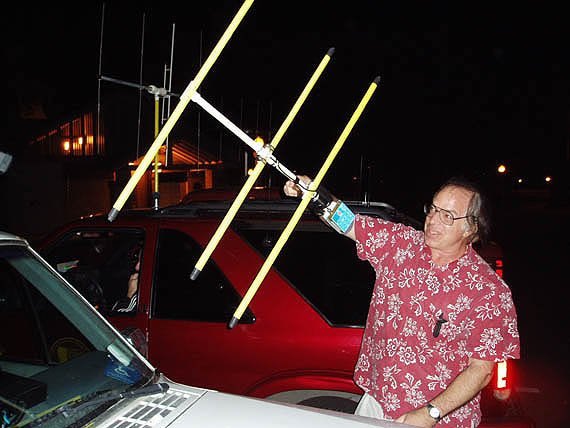
Getting back into the game, David Pepper WA6TWA sniffs out a hidden transmitter using a state-of-the-art two-meter RDF set from Australia.
For over 40 years, hidden transmitter hunters have prowled the streets in search of the elusive sources of unusual signals. Equipment has evolved, but the adventure and intrigue remain the same.
From an feature article in the Fall 2005 issue of CQ-VHF Magazine
To me, the best thing about ham radio is that it's not just one thing. Our hobby offers a myriad of bands, modes and activities, each with its own group of dedicated followers and proponents. I've tried most of them and they are all a blast. But to me, nothing can compare with the excitement of hidden transmitter hunting.
When you set out on a mobile transmitter hunt (which southern California hams call a "T-hunt"), you never know where you'll end up and you never know what you'll find there. What surprise awaits today? On-foot hunts are an equal challenge, where you can improve your physical conditioning and perhaps win medals against international opponents.
Transmitter hunting is far from new in Amateur Radio. QST magazines in the 1930's tell of on-foot hunts at ARRL conventions, where hams used rudimentary equipment -- just a galena crystal across the terminals of an earphone -- to "sniff" out a signal source.
The heyday of T-hunting began a half-century ago, when gasoline was cheap and the open road beckoned. One ham would take a portable transmitter to an unlikely location and put it on the air. The hunters, usually all starting from the same location, would try to see who was best at radio direction finding (RDF). Each hunt was a test of construction skills as well as tracking abilities, for no commercial RDF gear was available.
I went on my first T-hunt as a 12-year-old Novice. In the rolling plains of Nebraska where I lived, the insensitive two-meter rigs of the day could hardly talk from one town to the next. So our Novice two-meter voice privileges went unused. The local hams kept track of one another on the 75 meter phone band. Some of them had upgraded to the latest in ham technology: single sideband. The natural place for a transmitter hunt was right there on 75.
I was working toward my General Class license, learning to draw RF oscillator and amplifier schematics from memory, as was required back then. My pride-and-joy Hallicrafters SX-100 receiver was all I had for 75 meters, so I built a vibrator power supply for it out of junk car radio parts. It sat in the seat of the family convertible, with the wicker-weave antenna from an old AM radio up on a pole that I held high. Dad had to drive, of course. The antenna directivity was not good and we didn't find the transmitter, but I was hooked. Unfortunately, the club never had another hunt until after I graduated from high school.
At the same time in southern California, hams had discovered the delights of T-hunting on VHF. David Pepper WA6TWA was also age 12 when he first took a Saturday night ride to experience it. He had heard about it from Hal Rattray WA6SZY, who lived across the street. For David's first hunt, he was relegated to the back seat of Hal's car where he kept track of the flashlight and maps.

Getting back into the game, David Pepper WA6TWA sniffs out a hidden transmitter using a state-of-the-art two-meter RDF set from Australia.
"All of the cars were equipped with receivers, signal strength meters and other electronic gadgets," says David. "They also had strange looking antenna rotating devices and hand-held aircraft landing lights to show the way. The antennas ranged from beams, which looked like housetop TV antennas, to helicals with futuristic-looking spiral copper tubing protruding from dish-like structures."
T-hunting had become a popular sport in the City of Angels, attracting ten to twenty cars for each hunt. Inside were two or three persons. The driver concentrated on the road while the others handled all the gear and maps. Some attached their antennas to a window mount, while the others had to stop and get out of the car to get bearings.
Before the hunt, an organizer would record every vehicle's odometer reading. The most popular hunts were scored by mileage from start to finish, to encourage safe driving and careful map reading. Occasionally there were hunts in which the first-to-find was declared winner and mileage didn't count, but these "road races" weren't as popular. Afterwards, everyone headed to the famous Bob's Big Boy restaurant for treats, war stories, and mileage calculations.
According to WA6TWA, "Bulky and heavy vacuum tube AM gear was the order of the day. Commercial transceivers included Heathkit Pawnees and Gonset Communicators, or 'Gooney Birds' as they were called. The Gonsets had a weird fluorescent-green 'eye' tube. Its glowing pattern would open and close depending on the signal strength. This winking eye added intrigue to the strange chirping tones that assaulted my ears that night.
"We started at Darby Park near Hollywood Race Track," David continues. "Bearings were in the northerly direction. Some teams shot for the moon and headed toward Mount Wilson by freeway, hoping that the transmitter was in the mountains and they could minimize mileage through the city. We took a more conservative route along the side roads, taking antenna bearings every mile or so and ending up in the Verdugo Hills above Glendale, twenty miles from the starting point.
"As we got closer to the transmitter, the warbling, chirping sounds from our rig became more and more intense and the meters began to peg. Occasionally, the hidden operator would break the tension by getting on his microphone and exclaiming, 'This is the hidden transmitter, located on Mount Suribachi!' (See Note 1) Driving up the dark canyon roads on this moonless night was very exciting but even with our aircraft landing light in hand, we were unable to find the fire road that would have led us to the pot of gold at the end of the radio-wave rainbow. Nevertheless, I had a great time."
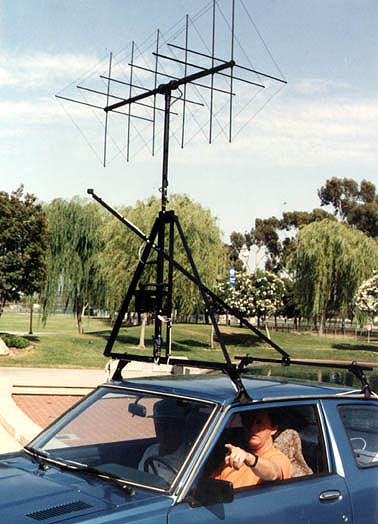
Unusual rotating VHF RDF beams are a common sight in southern California. JaMi Smith KK6CU (SK) built this motorized version in the 1990's. It turned at constant 6 RPM and displayed bearings in polar form on a storage oscilloscope.
Today's stamp-sized transmitter boards make it possible to really "hide" a transmitter. Back then, it was better to be in plain sight, using camouflage if necessary. Resourceful hiders had many tricks up their sleeves, as David discovered on his second outing. "The T was cleverly placed in full view of the traffic flow along La Cienega Boulevard, brightly illuminated by street lights above. The electronics were in a metal box with a cable emerging and neatly stretched across the street on the pavement. The antenna was attached to the other end of the cable and hidden from view in bushes.
"This contraption looked just like an official traffic counter," WA6TWA explains. "Most of the T-hunters drove over the cable along with the rest of the traffic flow. It was not until several miles down the road that we caught on, once we got bearings pointing behind us!"
Young David sought hunt rides wherever he could get them. By accompanying many different hunters, he learned what worked well and not-so-well. He was in for a surprise one night when he rode with one of the best T-hunters of the time. "The transmitter was right there at the Darby Park starting point in the brush. Output power was very weak to bluff everyone into thinking that it was miles away. However, the expert had a sixth sense as he drove about three blocks away from the starting point and patiently waited until the other hunters drove past. When I asked him why the delay, he told me that he had a hunch that the transmitter was closer to us than we first thought, in spite of the very weak signal.
"After taking a few more bearings, he said that it's back to the starting point for us. Once there, he took out his war surplus portable direction finder along with his flashlight and walked around the park with me closely behind. Ten minutes later, he found the transmitter hidden in the brush and the T-hunt for us was over almost before it started. In spite of this impressive display of talent, we were humbled because the winning car turned back after only 2 blocks and beat us by a fifth of a mile!"
Was it a coincidence that the hunters' vehicles looked like something from the popular science fiction movies at local drive-ins? "We would be routinely queried by onlookers as to what was going on," WA6TWA reports. "One of our more outrageous responses occurred on a T-hunt that took us along Hollywood Boulevard. When asked of our intent, we responded that a secret Russian Sputnik had landed in the area and we were tracking it down for the government."
That sort of flip answer may have brought trouble to some other hunters. Ken Walsh K6ZRL recalled, "One night, several of us found ourselves under arrest, albeit briefly. We weren't doing anything illegal, but a homeowner had complained about strange people with radio gear tramping through the countryside. One hot-shot officer crashed his patrol car in the fog during that caper."
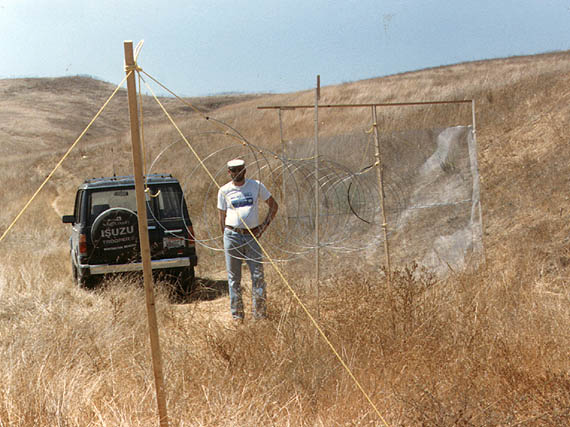
Huntmasters often use exotic antennas to help their signals bounce in the southern California hills. Gary Holoubek WB6GCT (SK) set up this 30-foot circularly-polarized two-meter helix beam for a Saturday night hunt.
Even though it was the midst of the cold war and many homes had fallout shelters, hams of the 1960's could hide radio gear in places that would be unthinkable today. WA6TWA says his most memorable transmitter find was in the TWA terminal at Los Angeles International Airport. He explains, "This predated the double-deck arrival/departure streets by decades. Back then, security was nonexistent by today's standards. No loudspeakers in front of the terminal urged cars and pedestrians to move on, no baggage searches were made, no security guards were on patrol, and no metal detectors or x-ray machines were to be seen.
"That Saturday night, our antenna bearings from Darby Park all pointed toward the beach. As we drove westward, we realized that LAX was to be our destination. More and more unusual cars began to pull up in front of the TWA terminal. When we couldn't find anything outside, we dismounted our antennas and equipment, then proceeded inside.
"There were three on my team, with interconnected equipment. One guy carried the buzzing vacuum tube receiver, another carried a heavy car battery to power the mobile unit, and I held a five-foot-long beam antenna to get directional readings. We strolled upstairs to the departure gates and eventually found the transmitter. It was in a briefcase plugged into the wall, left unattended next to a chair in the gate area just a few feet from the departure tunnel. A 19-inch coat hanger sticking out of the brief case served as the antenna."
When David moved up to Fairfax High School, he found an active Amateur Radio club. Of course he was eager to share his love of T-hunting with its members. He found a sympathetic ear in the Boys Vice-Principal who happened to be a ham. Mr Alm agreed to let the club hold lunchtime on-foot hunts.
WA6TWA continues the story: "When it was my turn to hide, I decided to use the room where we met for the weekly Chess Club tournament. I placed my ham radio set under a desk and turned it on. Only a barely perceptible buzz came from the rig, which was transmitting the strong signal. The tournament chess games continued as the hunters approached. In they came with their antennas, meters and loudspeakers blasting away with Martian-sounding chirps."
School authorities put a quick end to that hunt, but David was undaunted. Later, he found a way to go mobile without a gas-guzzling car by raiding his savings and purchasing a Honda touring motorbike. He says, "On a drizzly night, I tried to T-hunt on the cycle with my old Heathkit Pawnee strapped on the rack. I stopped the bike every few miles and, using my body as if it were a reflector dish, I twisted around with a spike antenna in front of me in a futile attempt to take bearings.
"I was the joke of my competitors in cars that night. A few miles from the starting point, my headlights began to dim and my engine began to sputter. I drained my motorcycle battery to a record-low charge level, but almost won the hunt. That night's transmitter was in a parking structure adjacent to the world famous Grauman's Chinese Theater in downtown Hollywood with a spike antenna dangling from the wall, a sure antenna-buster for anyone in a car."
Fast-forward to a few months ago, when WA6TWA and his wife Denise rode in my van for David's first T-hunt in three decades, and Denise's first ever. What a difference! Sensitive receivers have made high-power transmitters unnecessary most of the time. A half watt usually does it, and such a transmitter is a snap to conceal or disguise.
Hunt boundaries are much larger, encompassing over 2300 square miles on one of the Saturday night hunts. Rules of the "All-Day Hunts," which can last an entire weekend, merely require the transmitter to be within the continental USA and be copyable at the top of Rancho Palos Verdes.
A complete on-foot RDF setup with 3-element beam and receiver with tone-pitch S-meter weighs around two pounds and can be carried in one hand, even by a pre-teen. Doppler RDF sets can capture and display bearings on transmissions of only a few milliseconds, but their relative insensitivity and less-than-ideal performance with horizontally-polarized signals make them a secondary system for most of the hunters who use them here.
The favorite hunt vehicle is now a SUV. Equipment often includes laptop-based mapping software with GPS positioning. But that doesn't mean that T-hunting doesn't require skill any more. Hiders have learned how the local mountains can make signals bounce like billiard balls, giving false directional readings over wide area. Instead of being continuous, typical transmissions last only a few seconds.
Much of the time, there are three, four, five or more transmitters all on one frequency, each squawking for a few seconds at a time in random sequence. On the occasional "Free For All" hunt, each participant pre-hides one or more unattended "T-boxes," as they are called. Then for a set period, everyone tries to find each others' boxes. The winner is the team that finds the most.
Despite all the technical improvements, former southern California T-hunters of the 1960's still feel right at home today. Lowest-mileage scoring is still preferred, with Crenshaw Factor normalization to accommodate differences in odometers (see Note 2). There are fewer Bob's Big Boy restaurants out there, but everyone swaps stories after the hunt at Denney's, Coco's or Norm's.
Subterfuge, camouflage and deceit are still prized characteristics of hiders and their transmitters. Tiny "micro-T's" have been concealed in fenceposts, soda cans, sprinkler pipes, and cell phone cases. Once in a while, one will be a few yards from the hunters at the start point, just as WA6TWA experienced.
Even David's derided body-reflection maneuver from his motorcycle hunt has gotten its proper respect in this decade. Hunters routinely use the "body fade" technique to get approximate heading with just a VHF handi-talkie. If you hold the HT tight against your chest and turn around, there will be a null in strength when the signal source is behind you. It's not because your body is a reflector, but because it attenuates signals passing through it. As one hunter says, "The bigger the body, the better the bearing!"
Nowadays, hunters and hiders are more conscious about security. They check on (and heckle) one another during the hunt, but they do it with their cell phones so as not to give RDF hints of their locations. "No clues!" is still the foremost rule.
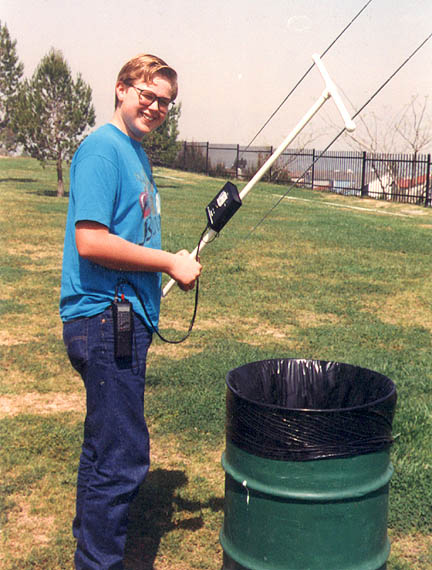
Jason McLaughlin KD6ICZ started riding along and sniffing out transmitters as he entered his teens. More than a decade later, he is still a fan of this ham radio sport.
Despite today's homeland security consciousness, T-hunters are rarely hassled by police. Experienced officers are used to our strange antenna arrays and slightly erratic driving. The give friendly waves as they pass by the hilltop starting points lined with hunters' vehicles and they usually ignore the fact that a couple of them protrude into the traffic lanes.
I'm sure that as we approached the hidden T that night, David got the same thrill he had on his first hunt. I think every ham should experience this thrill at least once. T-hunting skills have many benefits for Amateur Radio and the public, especially in volunteer enforcement and search/rescue. For David and me, experiencing it as a pre-teen was incentive to learn more about electronics and science, leading both of us to lifelong careers. I think that's still the best part of it, so I make it a point to take young persons on hunts, mobile or on foot, whenever possible.
WA6TWA's interest in the strange properties of invisible electromagnetic waves jump-started him toward a Ph.D. in Applied Physics from Caltech and employment as a researcher in physics and optics. He sums it up this way: "Hopefully, forty years hence, there will be many middle-aged persons who will reflect back on those innocent times at the turn of the 21st century when they first tried T-hunting as a youngster."
For results and stories of current mobile T-hunts in southern California, point your Web browser to www.thunter.org, provided by Steve Heinemann N6XFC and Deryl Crawford N6AIN. For more about Amateur Radio RDF in general, and on-foot hunts for all ages in particular, please visit other pages here at www.homingin.com.
---------------------
[Note 1] The famous flag-raising on the island of Iwo Jima was atop Mount Suribachi on February 23, 1945.
[Note 2] Prior to the hunt, each vehicle is driven on a standard course of approximately nine miles along Crenshaw Boulevard from the city of Torrance to a hilltop in Rancho Palos Verdes. The indicated mileage (Crenshaw Factor) is divided into elapsed mileage at the end of the hunt. The resulting Crenshaw Units for each team are compared to determine the winner.
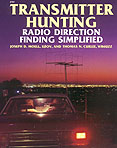 Text and photos © 2005 and 2008 Joseph D. Moell. All rights reserved.
Text and photos © 2005 and 2008 Joseph D. Moell. All rights reserved.
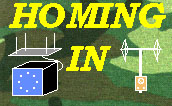 Back to
Transmitter Hunting, Southern California Style page
Back to
Transmitter Hunting, Southern California Style page
Back to the Homing In home page
This page updated 23 March 2011